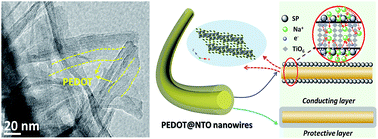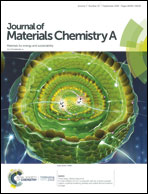Multi-functional PEDOT-engineered sodium titanate nanowires for sodium–ion batteries with synchronous improvements in rate capability and structural stability†
Abstract
Low electronic conductivity and poor structural stability of sodium titanate nanocrystals have restricted their potential application in sodium ion batteries (SIBs). General carbon-coating protocols at high temperature commonly initiate the surface reduction and grain growth of sodium titanate, resulting in structural distortion and sluggish ion diffusion. Herein poly(3,4-ethylenedioxythiophene) (PEDOT) encapsulated sodium titanate [NaTi3O6(OH)·2H2O, NTO] (PEDOT@NTO) composites were readily prepared by in situ oxidative polymerization of 3,4-ethylenedioxythiophene at room temperature in the presence of NTO nanowires. The as-fabricated PEDOT@NTO anode for SIBs delivers reversible capacities of 200.1 mA h g−1 at 20 mA g−1 and 80.5 mA h g−1 at 1000 mA g−1, which are much higher than 189.2 and 18.0 mA h g−1 for bare NTO at the same rates, respectively. A high capacity retention of 76.4% is also achieved for PEDOT@NTO after 1000 cycles at 200 mA g−1. Therefore, a large specific capacity and high rate and cycling capabilities are simultaneously achieved for PEDOT@NTO due to the synergistic effects of 3D architectures of intertwined nanowires and multi-functional PEDOT shells. In particular, the coated PEDOT layers effectively promote electron transport and ion diffusion, and also play a protective role in maintaining the structural stability of NTO during the charge/discharge processes. This work enables simultaneous improvements in both electronic and ionic conduction abilities of Ti-based nanomaterials, and would provide new insights into the surface engineering of nanoelectrodes with multi-functional shells.



 Please wait while we load your content...
Please wait while we load your content...